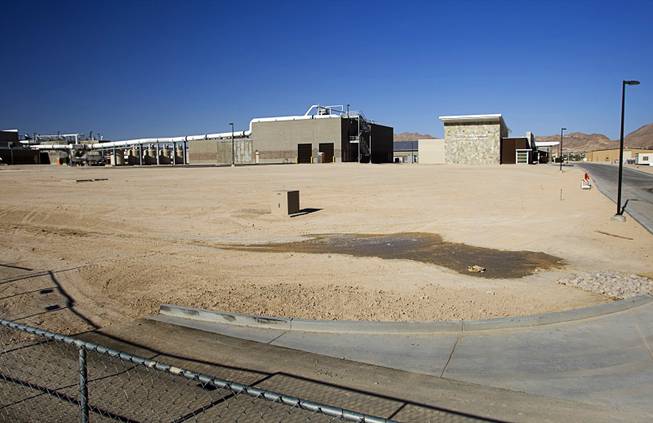
A view of the new City of North Las Vegas Water Reclamation Facility by Carey Avenue and Betty Lane Thursday, June 23, 2011. The city originally had planned to build a pipeline to transport the treated wastewater to Lake Mead but the city is now releasing treated water into the open Sloan channel that flows into Lake Mead.
Published Thursday, Nov. 1, 2012 | 11:44 a.m.
Updated Thursday, Nov. 1, 2012 | 12:34 p.m.
Clark County and North Las Vegas are a few “yes” votes away from resolving a year-old dispute that has victimized residents along the stinking, bug-infested Sloan Channel in the northeast valley.
County commissioners on Wednesday will be asked to endorse an agreement with the city to provide some funding to construct an above-ground pipeline on the existing Sloan Channel that will carry water from North Las Vegas’ wastewater treatment plant to Lake Mead.
The agreement staves off dueling lawsuits filed by the city and county that were set to be heard in January.
“This agreement is beneficial to both sides. It shows cooperation and concern for each other's constituents,” said County Commissioner Tom Collins, whose district includes the channel. He added it was “one of the hardest negotiations that the District Attorney's Office has ever had.”
After North Las Vegas opened its roughly $300 million treatment plant in 2011, it had no approved way of transporting the cleaned water to Lake Mead. Years earlier, the idea had been to receive funds from the Clean Water Coalition to construct an underground pipe, connecting the plant’s treated water with other treated wastewater pipes already flowing into the lake.
But the Clean Water Coalition now exists only by a thread, as most of the various local water reclamation bureaus decided a few years ago it wasn’t needed.
Without money to build an underground pipe, North Las Vegas began releasing treated water into the Sloan Channel, which was built by the county to handle floodwaters. The city did this without permission from the county.
Neighbors reported problems shortly after as algae grew in the warm water from the treatment plant, then left a rotten-egg smell as the algae decayed. Bugs were the next plague, swarms of which invaded Sloan Channel neighborhoods. The warm water also was fertile egg-laying territory for insects.
Shortly after it began releasing the water, North Las Vegas filed a federal lawsuit essentially asking the court to find the city had the right to use the channel. Clark County sued later for trespass and public nuisance, and sought declaratory and injunctive relief to stop the city from using the channel.
Under terms of the agreement before commissioners next week, North Las Vegas will transfer $8 million to the county to design and build a pipeline. The county will spend another $7 million, bringing the total cost to $15 million. The city will repay the county the $7 million with a portion if its quarter-cent sales tax distributed by the Southern Nevada Water Authority over the next 10 years.
More terms of the agreement include:
• North Las Vegas will have to perform maintenance on the channel, including “mitigation of odors, algae, midges, mosquitoes, flies, spiders, bats, birds, aquatic insects, pests and/or other nuisances” that result from the discharge.
• The city will pay $109,000 to the county within 30 days for costs resulting from the discharge to date.
• Paying the county $50,000 to secure the city’s maintenance obligations.
• Paying the county an annual $50,000 user fee until the pipeline is finished.
• Paying $1.5 million for future road and other improvements in the area of the wastewater plant.
The agreement also would require the North Las Vegas City Council to vote to dissolve the Clean Water Coalition, which it had not wanted to do previously because of pipeline issues.
Years ago, Collins said, the pipeline was calculated at a much higher cost because engineers designed it to go completely underground. This new design will have the pipeline above ground in the Sloan Channel. Only where bridges intersect the channel, he added, will the pipeline have to go underground.
He said engineers have assured the city and county the pipe would not take up so much room that it would push water above the sides of the channel during a rainstorm.

Join the Discussion:
Check this out for a full explanation of our conversion to the LiveFyre commenting system and instructions on how to sign up for an account.
Full comments policy